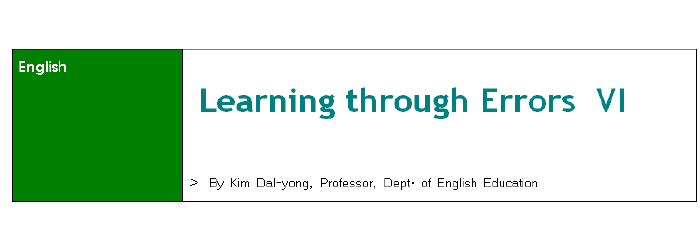
Misordering errors are characterized by “the incorrect placement of a morpheme or group of morphemes in an utterance.” Learners of English as a first or second language sometimes misplace some items in English constructions that may be correctly placed in more than one place in the sentence, as in
They all are all the time late.
When Kim was once a small boy, he was suddenly struck dumb and became too stiff to move.
Misordering errors occur systematically for both first and second language learners especially in their constructions of direct and indirect interrogative sentences. In the utterance, “What Daddy is doing?” the learner uses the declarative sentence order that he or she has already studied. When he or she has acquired the direct (simple) question order, he or she produces “I don’t know what is that,” using the simple question order “what is that?” The learner erroneously follows the rule for simple questions rather than for indirect (embedded) questions. Misordered constructions of simple and embedded questions can be explained in a developmental perspective and counted as intralingual errors.
Some of second language learners’ misplaced constructions, however, are word-for-word translations of native language surface structures. The learners tend to do a word-for-word or sense-for-sense translation of the words or phrases of their first language without considering word-order rules in second language constructions. Learners of English as a second language can properly render lexical items into a good English utterance when they have acquired a wide range of information, not only about the meanings of English word choices but also about how the English language combines its collocational and syntactic behaviors and what values and perceptions the behaviors produce. Many constraints are placed in the English utterances of a second language learner by the sociocultural content of communication. When he or she recognizes the cultural background initiated in the English language, he or she can understand English-speaking people’s culturally conditioned language behaviors and traits. Second language learners’ misordering errors are not just a violation of the second language’s syntactic rules but also an awkward misplacement of items in the language constructions that interferes with the natural flow or proper association of the items for the completion of the utterance.
Learners of English as a second language sometimes make errors in embedding English patterns due to their first language interference. Some subject-verb inversions that Korean learners of English as a second language make in wh-questions can be traced to Korean inference, as in “What city you like more?” The Korean language does not require a reversal of word-order rules that are used for the declarative sentence order. Many researchers about second language learners’ acquisition of English interrogative show that their misordering errors are usually counted as developmental errors because the errors decrease in number or in diversity while they are learning many cases of word-order rules. However, first language influence cannot be denied in the learners’ misordering errors both in wh-questions without inversion and in embedded questions with inversion. Korean-speaking adolescents’ acquisition of English question forms is similar to international students’ learning English as a second language, but the case of subject-verb inversion in the interrogative sentence could also be an example of Korean interference.
We have seen that second language learning is a conscious or unconscious construction of a new system for understanding and producing utterance in second language. Errors in the interlanguage systems of second learners are not failures to memorize and practice prefabricated and given rules for second language learning. Interference from first language and mutual transfer of items within second language are major sources of difficulty in second language learning. But second language errors are made in the process of acquisition. However incorrect his or her rules may be from the standpoint of the accepted grammar of the native speaker, a second language learner uses them in the creative mode. His or her sentences are grammatical in terms of his or her own grammar because he or she constructs his or her own legitimate system of language. The errors need to be examined to investigate the entire linguistic system of the learners. A second language learner will even impede that process if he or she does not commit errors, but he or she benefits in turn from various forms of feedback on his or her errors. Second language learning involves a process in which success comes by profiting from errors, by using errors to obtain feedback from the environment, and by making new attempts with that feedback that successively approximate desired goals.
A second language learner is processing language on the basis of his or her own interlanguage. The interlanguage is a system that lies between the two languages and thus ought not to have the value judgments of either language placed upon it. The learner’s interlanguage system should not necessarily be treated as a product of malformed language replete with mistakes. The system is rather as a flexible, dynamic approximate system, reasonable to a great degree in their mind, albeit idiosyncratic, so it is a necessary stage in the gradual acquisition. The learner’s capacity to handle target language material must improve in the indeterminate areas of language use concerned. This affirmative perspective results in a deeper understanding of the process of second language acquisition. Progress in learning a second language is made by adapting linguistic strategies to match the facts of the language. Errors which a second language learner makes in this process of constructing a new system of language possibly hold in them some of the keys to the understanding of the process of second language acquisition.

